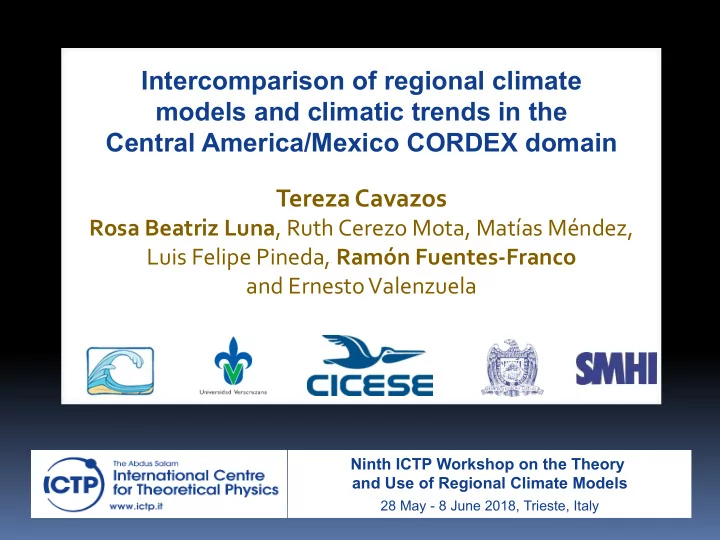

Intercomparison of regional climate models and climatic trends in the Central America/Mexico CORDEX domain Tereza Cavazos Rosa Beatriz Luna , Ruth Cerezo Mota, Matías Méndez, Luis Felipe Pineda, Ramón Fuentes-Franco and Ernesto Valenzuela Ninth ICTP Workshop on the Theory and Use of Regional Climate Models 28 May - 8 June 2018, Trieste, Italy
Objectives Evaluate 3 RCMs in the CORDEX-CAM domain and obtain Temp y Precip trends for 1980-2010
CONTENT 1. Introduction 2. Objective, data and methodology 3. Inter-comparison of RCMs 4. Climatic trends CORDEX-CAM 5. Interannual/decadal variability 6. Conclusions http://www.cordex.org/
1. Introduction OBS: Global Air Temperature Anomaly Global Ocean Heat Content 1970 Ta global = 15 o C
Observations: NH and SH Temperature Change NASA GISS site
Temperature Trends ( o C/decade) 1930-2004 + - OBS: CRU CMIP5 ensemble (Kumar et al. 2013b, J. Clim, 26, 4168-4185)
Positive Temp trend in the more recent period JJA + + + DJF (Kumar et al. 2013a, J. Climate, 26, 4168-4185)
Precipitation Trends (mm/decade) 1930-2004 + - CRU + - CMIP5 ensemble (Kumar et al. 2013b, J. Clim, 26, 4168-4185)
GHCN: Precipitation Trends (mm/decade) 1930-2004 + Incomplete data (Kumar et al. 2013b, J. Clim , 26, 4168-4185; consistent with New et al ., 2001, IJOC) Obs CMAPrecip Trend (%/ - decade) 1979-1999: Negative trend in the subtropics/tropics (New et al ., 2001)
2. Data and Methodology Linear trends (p<0.05). RCA4 and RegCM4.0 (CORDEX-CAM): Regional trends with https://www.cordex.org/output/esgf-menu.html Mann-Kendall trend test and Sen’s slope PRECIS: UNAM, Mexico; RegCM4.5: Universidad de Veracruz, Mexico
Methodology ICBC: ERAIN 75 Reanalysis Simulation: 1979-2010 Spin up: 1979 Analysis: 1980-2010 Resolution: 50 km Core: Hydrostatic RegCM4 Emanuel è ocean
Physical parameterizations Physical Options PRECIS (HadRM3P) RCA4 RegCM4.0-G (Grell) RegCM4.5-T (Tiedtke) Kain and Fritsch (1990, 1993), Convection-c (continent) Gregory and Rowntree (1990) Grell (1993) Tiedtke (1989, 1996) Kain (2004) Kain and Fritsch (1990, 1993), Convection-o (ocean) Gregory and Rowntree (1990) Emanuel (1991) Emanuel (1991) Kain (2004) Microphysics SUBEX SUBEX Smith (1990) Rasch and Kristjánsson (1998) or moisture scheme (Pal et al. , 2000) (Pal et al. , 2000) MOSES2 BATS BATS Land-surface Samuelsson et al., (2006) (Essery et al. , 2003) (Dickinson et al., 1993) (Dickinson et al., 1993) Savijarvi (1990), Sass et al., CCM3 CCM3 Radiation Edwards and Slingo (1996) (1994) (Kiehl, 1996) (Kiehl, 1996) Planetary Boundary Layer Holtslag Holtslag (PBL) (Holtslag, 1990) (Holtslag, 1990)
North American monsoon (NAM) and Mid-summer drought (MSD)
3. Metrics of evaluation (1980-2010) NAM Region Temperature ( o C) Precipitation (mm/month)
MSD Region Temperature ( o C) Precipitation (mm/month)
Annual precipitation bias with respect to GPCP (1980-2010) ERA-Int PRECIS Mean Annual Precipitation CRU GPCP RCA4 RegCM4.0-G ITCZ (mm) RegCM4.5-T Wet bias: >3 mm/d (mm/yr)
Temperature bias ( o C) with respect to CRU (1980-2010) CRU Mean Annual Temperature ( o C) ERAIN PRECIS RCA4 RegCM4-G Topo RegCM4.5-T
4. Decadal trends of temperature ( o C/decade) 1980-2010 CRU ERA-Int RegCM4.0-G PRECIS RCA4 RegCM4.5-T RCMs weak negative trend è wet trend? Dots: Stat significance at 95%
Mean annual temperature in the NAM and MSD (1980-2010) NAM MSD
NAM region: Mean annual temperature (1980-2010) NAM Observed Temperature Trend: 0.4 o C/decade significant at the 95% level Detrended temperature variation is not associated with the AMO, PDO nor ENSO
CRU decadal trends of seasonal temperature ( o C/decade) 1980-2010 DJF JJA In the NAM region: Each decade has become warmer since 1970 to 2015, NAM especially in JJA region (CRU Temp)
5. Decadal trends of precipitation (mm/decade) 1980-2010 Dots: Stat signif at 95% CRU GPCP RCA4 RegCM4.0-G ERA-Int PRECIS RegCM4.5-T CRU & GPCP Opposite signs in GM and Caribbean Color scale can be deceiving as in the tropics it rains a lot!
Decadal trends of precipitation (%/decade) 1980-2010 CRU GPCP RCA4 RegCM4.0-G ERA-Int PRECIS RegCM4.5-T Negative trend in the subtropics is consistent with New et al. (2001) for 1979-1999
Annual Precipitation Trends in Mexico (CLICOM data) 100 100 300 200 200 300 clicom-mex.cicese.mx
Mean annual precipitation in the NAM and the MSD
Correlation with detrended variables (1980-2010) MSD region: +AMO and El Niño: more Temp +AMO and La Niña: more Precip è Warm North Atlantic, cold tropical Pacific
Conclusions v Evaluation: RCMs capture annual T cycles, but tend to be cooler and drier than observed (exception RegCM4.5). Precis is good at capturing Temp. v Trends: Observations and RCMs show a warming trend (0.4 o C/ decade)* in the NAM region that does not appear to be related to PDO, AMO, nor ENSO. v Observed negative Precip trend in the subtropics is captured by the RCMs, but large uncertainties in the tropics (too wet) v CRU and GPCP show opposite Precip trends over the Gulf of Mexico and the Caribbean region; more uncertainties v Teleconnections: + AMO and El Niño years are associated with warmer years in the MSD region. v + AMO and La Niña conditions favor more rainfall in the MSD region.
This workshop – CORDEX-CAM Group 04 Analysis: Intercomparison Models: Add RegCM4.7 Period: 1998-2002 Regions: NAM and MSD
Grazie Gracias! Thank you especially to Filippo, Graziano and Erika tcavazos@cicese.mx
Recommend
More recommend